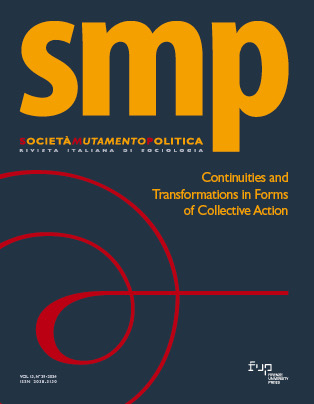Published 2024-07-23
Keywords
- Five Star Movement,
- political communication,
- leadership,
- digital parties
How to Cite
Copyright (c) 2024 Giovanni Barbieri, Lucia Montesanti, Francesca Veltri

This work is licensed under a Creative Commons Attribution 4.0 International License.
Abstract
This study aims to reconstruct the history of the Five Star Movement by taking the connection between communication and power as our main reference point. This choice is not accidental, given that this connection has acquired a greater relevance in our epoch, characterized by the emergence of mass self-communication and the so-called web society. Furthermore, so-called digital parties, whose activities are mainly based on digital technology, are currently spreading in many areas of the world. The main goals of this study consist of understanding how the communication-power link in the Five Star Movement has changed over time, identifying who actually holds power within it, and evaluating whether it is possible to still define it as a digital party.
References
- Amoretti F., Fittipaldi R. e Santaniello M. (2021). «Poteri monocratici e comunicazione politica ai tempi della pandemia. Dal governo Conte II al governo Draghi», in Comunicazione Politica, 3: 333-356.
- Bernays E.L. (2012 [1928]), Propaganda. Della manipolazione dell’opinione pubblica in democrazia, Lupetti, Bologna.
- Bimber B. e Davis R.J. (2003), Campaigning Online: The Internet in U.S. Elections, Oxford University Press, Oxford.
- Biondo N. e Canestrari M. (2018), Supernova. Segreti, le bugie e i tradimenti del MoVimento 5 stelle: storia vera di una nuova casta che si pretendeva anticasta, Ponte alle Grazie, Milano.
- Biorcio R. e Natale P. (2018), Il Movimento 5 Stelle: dalla protesta al governo, Mimesis, Sesto San Giovanni.
- Bordignon F., Ceccarini L., Chiusi F., Gualdo R. e Dottori G. (2013), «Fenomenologia di Beppe Grillo», in Limes, https://www.limesonline.com/cartaceo/fenomenologia-di-beppe-grillo.
- Calise M. e Musella F. (2019), Il principe digitale, Laterza, Roma-Bari.
- Castells M. (1996), The Rise of the Network Society, Blackwell, Oxford.
- Castells M. (2009), Communication Power, Oxford University Press, Oxford.
- Chadwick A. (2013), The Hybrid Media System: Politics and Power, Oxford University Press, Oxford.
- Chiaramonte A. (2010), «Dal bipolarismo frammentato al bipolarismo limitato? Evoluzione del sistema partitico italiano», in R. D’Alimonte e A. Chiaramonte (a cura di), Proporzionale se vi pare. Le elezioni politiche del 2008, il Mulino, Bologna, pp. 203-228.
- Corbetta P. e Gualmini E. (2013), Il partito di Grillo, il Mulino, Bologna.
- Cremonesi C. e Presi M. (2012), «Presi un dvd a Grillo per capire i miei errori», in Corriere della Sera, 14 giugno 2012, Disponibile online http://archiviostorico.corriere.it/2012/giugno/14/Presi_dvd_Grillo_per_capire_co_9_120614031.shtml
- Gerbaudo P. (2020), I partiti digitali. L’organizzazione politica nell’era delle piattaforme, il Mulino, Bologna.
- Iacoboni J. (2018), L’esperimento. Inchiesta sul Movimento 5 Stelle, Laterza, Roma-Bari.
- Karpf D. (2011), «MoveOn.org e la nuova generazione di gruppi di pressione», in L. Mosca e C. Vaccari (a cura di), Nuovi media, nuova politica? Partecipazione e mobilitazione online da MoveOn al Movimento 5 stelle, FrancoAngeli, Milano, pp. 167-186.
- Lusoli W. e Ward S. (2004), «Digital rank-and-file: party activists’ perceptions and use of the internet», in The British Journal of Politics and International Relations, 6, 4: 453-470.
- Pederson K. e Saglie J. (2005), «New Technology in Ageing Parties», in Party Politics, 11(3): 359-377.
- Rullo L. e Nunziata F. (2021), «Sometimes the Crisis Makes the Leader? A Comparison of Giuseppe Conte Digital Communication Before and During the Covid-19 Pandemic», in Comunicazione Politica, 22(3): 309-332.
- Segatori R. (1999), L’ambiguità del potere. Necessità, ossessione, libertà, Donzelli, Roma.
- Sikk A. (2005), «How Unstable? Volatility and the Genuinely New Parties in Eastern Europe», in European Journal of Political Research, 44(3): 391-412.

